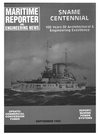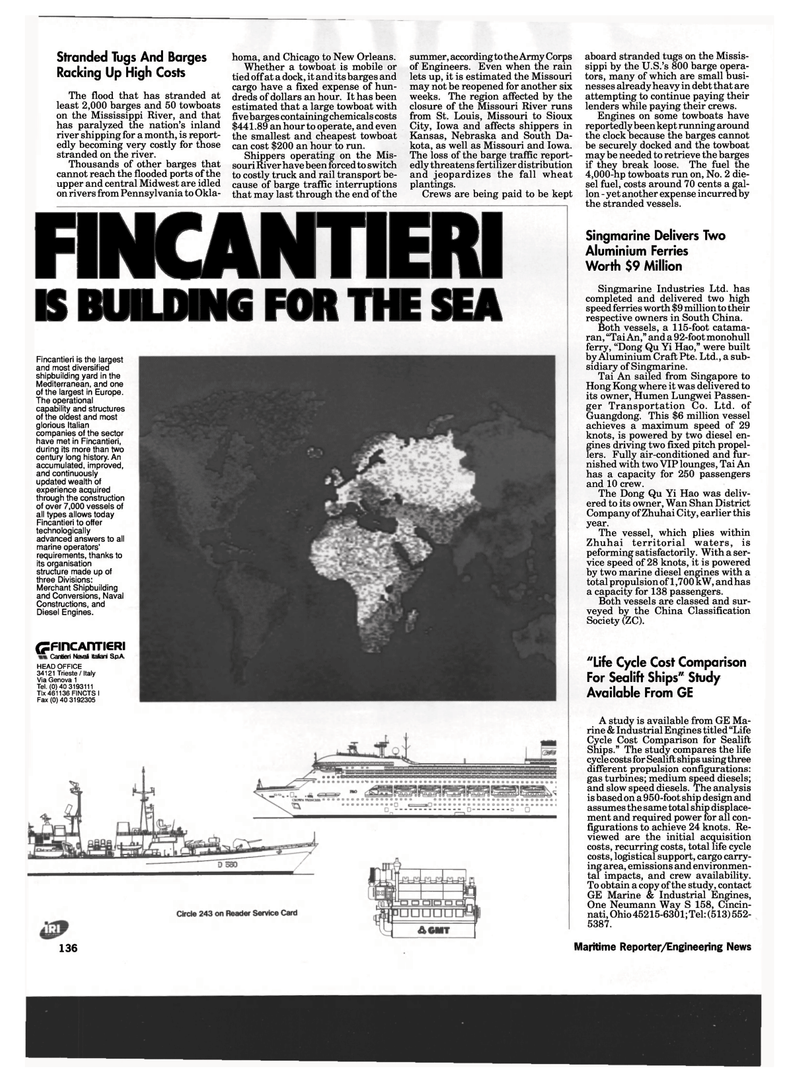
Page 142: of Maritime Reporter Magazine (September 1993)
Read this page in Pdf, Flash or Html5 edition of September 1993 Maritime Reporter Magazine
Stranded Tugs And Barges
Racking Up High Costs
The flood that has stranded at least 2,000 barges and 50 towboats on the Mississippi River, and that has paralyzed the nation's inland river shipping for a month, is report- edly becoming very costly for those stranded on the river.
Thousands of other barges that cannot reach the flooded ports of the upper and central Midwest are idled on rivers from Pennsylvania to Okla- homa, and Chicago to New Orleans.
Whether a towboat is mobile or tied off at a dock, it and its barges and cargo have a fixed expense of hun- dreds of dollars an hour. It has been estimated that a large towboat with five barges containing chemicals costs $441.89 an hour to operate, and even the smallest and cheapest towboat can cost $200 an hour to run.
Shippers operating on the Mis- souri River have been forced to switch to costly truck and rail transport be- cause of barge traffic interruptions that may last through the end of the summer, according to the Army Corps of Engineers. Even when the rain lets up, it is estimated the Missouri may not be reopened for another six weeks. The region affected by the closure of the Missouri River runs from St. Louis, Missouri to Sioux
City, Iowa and affects shippers in
Kansas, Nebraska and South Da- kota, as well as Missouri and Iowa.
The loss of the barge traffic report- edly threatens fertilizer distribution and jeopardizes the fall wheat plantings.
Crews are being paid to be kept
FINCANTIERI
IS BUILDING FOR THE SEA
Fincantieri is the largest and most diversified shipbuilding yard in the
Mediterranean, and one of the largest in Europe.
The operational capability and structures of the oldest and most glorious Italian companies of the sector have met in Fincantieri, during its more than two century long history. An accumulated, improved, and continuously updated wealth of experience acquired through the construction of over 7,000 vessels of all types allows today
Fincantieri to offer technologically advanced answers to all marine operators' requirements, thanks to its organisation structure made up of three Divisions:
Merchant Shipbuilding and Conversions, Naval
Constructions, and
Diesel Engines. (pFincAnrieRi
CanCeri Naval Italian* S.pA
HEAD OFFICE 34121 Trieste / Italy
Via Genova 1
Tel. (0) 40 3193111
Tlx 461136 FINCTS I
Fax (0) 40 3192305 136 aboard stranded tugs on the Missis- sippi by the U.S.'s 800 barge opera- tors, many of which are small busi- nesses already heavy in debt that are attempting to continue paying their lenders while paying their crews.
Engines on some towboats have reportedly been kept running around the clock because the barges cannot be securely docked and the towboat may be needed to retrieve the barges if they break loose. The fuel the 4,000-hp towboats run on, No. 2 die- sel fuel, costs around 70 cents a gal- lon - yet another expense incurred by the stranded vessels.
Singmarine Delivers Two
Aluminium Ferries
Worth $9 Million
Singmarine Industries Ltd. has completed and delivered two high speed ferries worth $9 million to their respective owners in South China.
Both vessels, a 115-foot catama- ran, "Tai An," and a 92-foot monohull ferry, "Dong Qu Yi Hao," were built by Aluminium Craft Pte. Ltd., a sub- sidiary of Singmarine.
Tai An sailed from Singapore to
Hong Kong where it was delivered to its owner, Humen Lungwei Passen- ger Transportation Co. Ltd. of
Guangdong. This $6 million vessel achieves a maximum speed of 29 knots, is powered by two diesel en- gines driving two fixed pitch propel- lers. Fully air-conditioned and fur- nished with two VIP lounges, Tai An has a capacity for 250 passengers and 10 crew.
The Dong Qu Yi Hao was deliv- ered to its owner, Wan Shan District
Company of Zhuhai City, earlier this year.
The vessel, which plies within
Zhuhai territorial waters, is peforming satisfactorily. With a ser- vice speed of 28 knots, it is powered by two marine diesel engines with a total propulsion of1,700 kW, and has a capacity for 138 passengers.
Both vessels are classed and sur- veyed by the China Classification
Society (ZC). "Life Cycle Cost Comparison
For Sealift Ships'' Study
Available From GE
A study is available from GE Ma- rine & Industrial Engines titled "Life
Cycle Cost Comparison for Sealift
Ships." The study compares the life cycle costs for Sealift ships using three different propulsion configurations: gas turbines; medium speed diesels; and slow speed diesels. The analysis is based on a 950-foot ship design and assumes the same total ship displace- ment and required power for all con- figurations to achieve 24 knots. Re- viewed are the initial acquisition costs, recurring costs, total life cycle costs, logistical support, cargo carry- ing area, emissions and environmen- tal impacts, and crew availability.
To obtain a copy of the study, contact
GE Marine & Industrial Engines,
One Neumann Way S 158, Cincin- nati, Ohio 45215-6301; Tel: (513) 552- 5387.
Maritime Reporter/Engineering News

 141
141

 143
143
